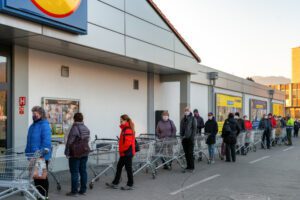 Regardless of how many times I see it, I am always astounded to find bread and milk shelves laid bare prior to a forecasted snowstorm. In the 40 something years I have lived in the metro, I cannot remember a single occasion when two days after inclement weather I was not able to safely travel to a desired location. Yet before a snowstorm, even I find myself having to fight the temptation to pick up some extra supplies just in case.
Regardless of how many times I see it, I am always astounded to find bread and milk shelves laid bare prior to a forecasted snowstorm. In the 40 something years I have lived in the metro, I cannot remember a single occasion when two days after inclement weather I was not able to safely travel to a desired location. Yet before a snowstorm, even I find myself having to fight the temptation to pick up some extra supplies just in case.
This phenomenon, known as panic buying, has probably never been more on display in my lifetime than over the past year and a half. The great toilet paper shortage of early 2020 is a perfect example of how quickly an irrational fear of not having enough of something can turn into a reality when people act on these impulses.
According to Lisa Brateman, a New York City based psychotherapist, this behavior is primarily triggered as a response to feeling like a situation is out of the person’s control. By purchasing items, they view as essential, it may help to reduce the fear they are experiencing about not knowing what will happen in the near future. In other words, taking action, even if that action is illogical, helps to give the person a certain amount of peace of mind.
Part of the added danger of panic buying is not only that you buy things you don’t need, but it can also cause you to pay more than you should for the things you actually might need. A perfect example of this also occurred during the early months of Covid. As shrewd people saw the growing fear of the pandemic, many began buying and reselling items at exponentially higher than normal prices. In North Carolina individual containers of sanitizer were being sold for as much as $90 a bottle. In Minnesota, a smoke shop sold small packages of toilet paper for 79.99 each, and a Florida man even successfully sold 15 packs of N95 masks for $3,799.
Being a pure capitalist, I’m not necessarily faulting the individuals who profited off these fears. I am however, questioning the judgement of those who paid these ridiculous prices for things that in reality they should have known would slowly appear back on the shelves.
As we enter into the holiday season, both the media and retailers are stoking a feeling of urgency and panic when it comes to supply chains because, as we all know, fear sells. I’m not saying that empty shelves don’t exist, or that the images of all the shipping containers sitting idle in our ports are figments of our imagination. What I am saying is you should question the motivations of those telling you if you don’t rush to the store tomorrow you might miss out and your Thanksgiving and Christmas will need to be cancelled.
I can say with confidence this form of panic buying is indeed happening. Nearly a month ago my own mother purchased a Thanksgiving turkey out of a fear that none would exist closer to the big day. That fear, as I suspected, has shown itself to be completely unfounded and led to her having to store the more expensive bird longer than she really needed to.
Black Friday will soon be upon us, and with that comes even more opportunities to panic buy. As everyone around you scrambles to grab the must have doorbusters off the shelf, my advice is to wait, and be patient. As merchants realize they have more supply on hand than they originally expected many may participate in the act of panic selling, and that is when you as a consumer can really win.
